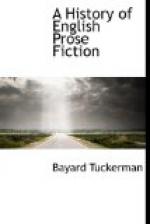The “Canterbury Tales” are so familiar that an extended notice of them here would be superfluous, especially as we are dealing with narratives in prose form. But in seeking to trace the origin and progress of the English novel as it is now written, we must record the first appearance of its special characteristics in the works of Chaucer. Here are first to be seen real human beings, endowed with human virtues and subject to human frailties; here fictitious characters are first represented amid the homely scenes of daily life; here they first become living realities whose nature and dispositions every one may understand, and with whose thoughts every one may sympathize. We must notice, also, the significant fact that of the thirty-two pilgrims who jogged along together that April day, four were of a military character, eleven belonged to the clergy, and seventeen were of the common people. A century before Chaucer’s time, when the feudal spirit was still all-powerful, there were but two classes of men thought worthy of consideration, the knighthood and the clergy; and in the romances of chivalry knights and priests exclusively composed the dramatis personae. But the slow progress of the masses, in whom lies the chief strength of a nation, becomes visible in Chaucer’s time. In the towns the tradesmen were rising to wealth and consideration. In the country the yeomanry—the laborers and farmers—were throwing off their serfdom, and emerging from the chrysalis of obscurity in which they had long been hidden. At Cressy and Poitiers the English archers disputed with the knighthood the honors of victory. While Chaucer was planning the “Canterbury Tales,” introducing into his gallery of contemporary portraits more figures of tradesmen than of knights or priests, the Peasant Revolt took place; the common people, long trodden in the dust, rose in defence of their rights as men, and John Ball, the “mad priest of Kent,” asked questions of the yeomen about him which showed how surely the Middle Ages were becoming a part of the past. “By what right are they whom we call lords greater folk than we? * * * If we all came of the same father and mother, of Adam and Eve, how can they say or prove that they are better than we, if it be not that they make us gain for them by our toil what they spend in their pride?” * * * “When Adam delved and Eve span, who was then the gentleman?"[26] As in the history of Chaucer’s time, so in his “Canterbury Tales” we perceive the decline of feudal and priestly tyranny which had gone hand in hand: the one keeping up a perpetual state of war and violence; the other limiting and enfeebling the human intellect, the activity of which could alone raise mankind out of barbarism.




